
With Jot existing before the game, albeit in a smaller capacity, we wanted to know whether James felt okay ‘re-using’ the character. “I think when you haven’t done anything that is really super established yet, aside from Pokémon or the official projects that you’ve worked on, no one really cares that much. A few people read my online comic, [if] I can transfer them across to the game… they might be happy to see him!”
Moving Jot – and other characters like Moonbeard (the in-game helper character) – from a cute online comic to a video game all about a children’s book felt completely natural. It was a “very early idea” to frame The Plucky Squire around a storybook that you can jump in and out of, all born from his art style.
“I have this simple, minimalist illustration style, and I wanted to make a game featuring that style. So I was thinking about what that could be, and the idea that came to mind was a kid’s book.” His early art was partially inspired by a storybook – Helen Nicoll and illustrated by Jan Pieńkowski’s Meg and Mog, a British staple – because of the “boldness of those illustrations”.
Discussions with his co-director Bidds evolved pretty quickly, with Turner soon thinking not just outside of the box, but outside of the book. To do that, the pair wanted to expand on an element that’s key to the game. “The idea of surprise was an interesting one to us. You turn the page and there’s a new surprise on every page [when you read a book]. And then we were thinking, ‘What could be the ultimate surprise? What if you could jump out of the book and run around?’”
It was a surprise every time it happened while we were playing. Even transitioning between the left and right page of the book, Jot goes from 2D to 3D as he somersaults through the air, and then back to 2D as he lands on the opposite page. That element of the unexpected is something the team found “kind of difficult.” There are gameplay shifts, secrets, and gameplay mechanics that have been hinted at or teased, but there are many more surprises awaiting.
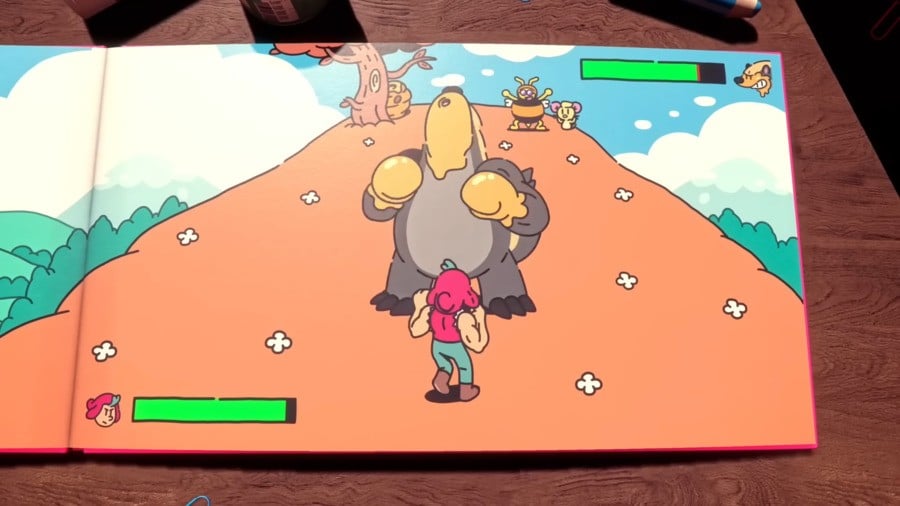
“There’s always a push and a pull,” Turner expressed. “Marketing wants to show more of the game but at the same time they totally understand that you don’t want to give a lot away, but you want to put something cool and flashy in the trailer…. But you don’t want to spoil the experience.”
Right at the beginning of our time with the game, we were greeted with a charmingly-narrated section which felt like it was ripped straight out of a BBC kids show. When we asked about that, Turner – who is from the UK – nodded with a smile. “The narrator is Philip Bretherton. He was actually an actor in a BBC series, so he has that kind of experience. He’s great. I love working with him and recording all the narration. There’s a website for an agency called Damn Good Voices with loads of actors on there with little clips of their work, so we just went through them, trying to find the kind of voice that we liked.” The team knew when they found the right person because Bretherton was “not just the kind of voice, this is the voice.”
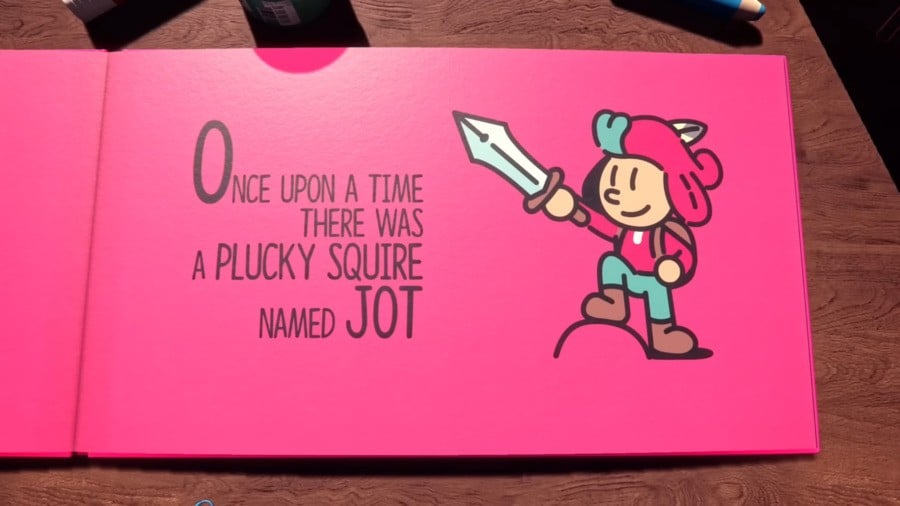
This is exactly the kind of attention-to-detail that stood out to us while playing The Plucky Squire. Translating Turner’s “minimalist” art style to 3D is something that works really well, and we couldn’t help but ask about the process behind making Jot look great in 3D.
“We were a bit too literal at first, actually. We did cell shading of Jot when he was outside of the book to make him look more like he does [in the book], but it kind of got rid of the feeling of weight of the outside world for some reason… [Because Jot is] the centre of your focus, [it] almost determines how the entire stage feels to you.” The team swapped to a “properly 3D-shaded” style, and Turner says that it immediately “grounded” the hero more. “We kept his face very simple… we didn’t give him the whites of his eyes, we kept those two marks.”
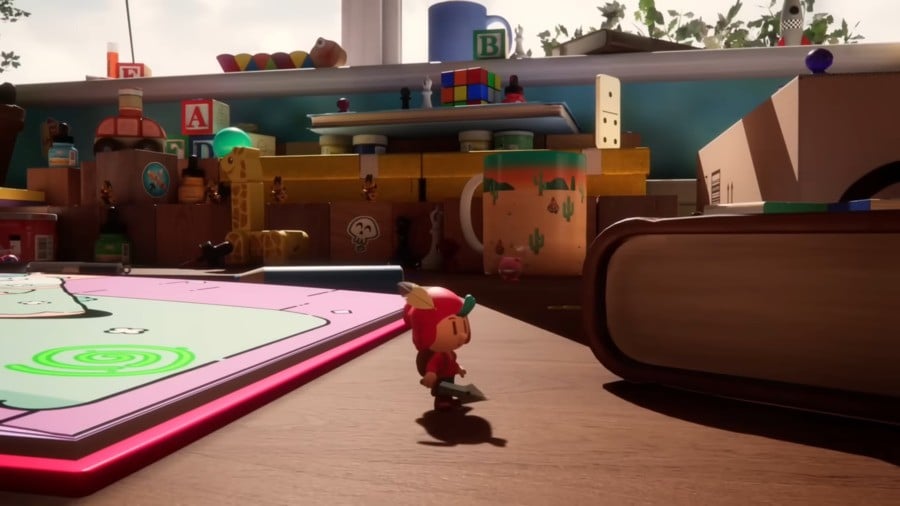
While the book and the element of surprise are two parts of The Plucky Squire, this is also a game about preserving creativity and allowing kids to express themselves. We saw so much of this throughout our time with the game, and Sam – the boy who is at the heart of the story and who loves The Plucky Squire book – has a presence that’s felt throughout thanks to the doodles on the desk, the stickers lying around, and who exactly makes all the mess on these desks. We didn’t see Sam himself, but we feel like we already know who he is.
The stickers, in particular, stood out to us – the level we played through was space-themed, so we saw aliens, planets, and quirky colours all adhered to the wooden desk. Those stickers were actually hand-drawn by Turner’s friends. One particularly noteworthy contributor was the designer of Geralt from The Witcher; we didn’t get a chance to ask who else may have contributed, but these are the kind of Easter Eggs that will have us digging around the game like excited kids.
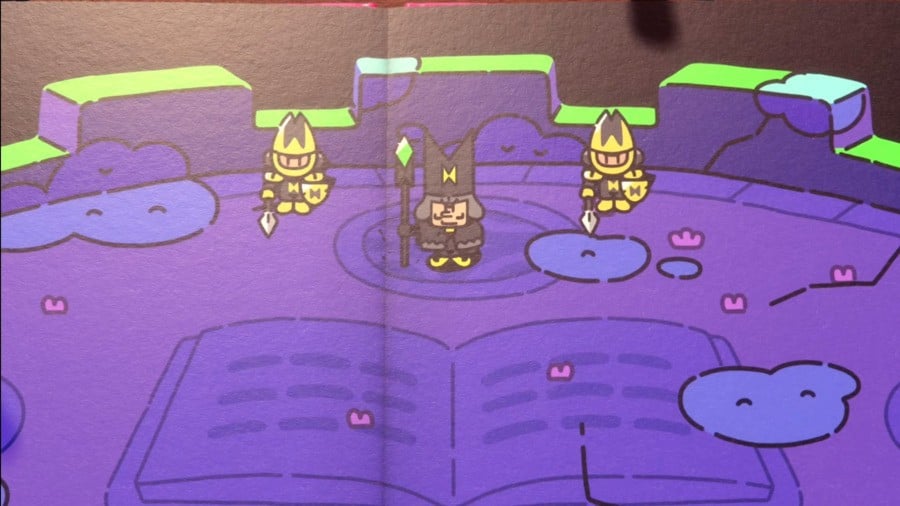
If it’s not apparent already, children and childlike wonder are at the heart of the game. Turner explained the consequences of the game’s story to us. “If Humgrump [the villain who is trying to end creativity] takes over the book, that’ll be bad for their world but it will also be bad for Sam because it’s his favourite book and he’ll kind of lose inspiration. You’re fighting for your own world but you’re also fighting to keep Sam inspired.” And the set dressing really gives a sense of that childlike curiosity we want to preserve.
The Plucky Squire is “a topic of conversation” in the Turner household. “My son calls it ‘The Plucky Square’,” he told us. Turner’s kids have helped inspire some choices for the game, from showing them levels and testing right down to character designs: “I’ll show my son a design and get his approval for it – which one is cuter or which one looks cooler – and he’ll pick out the designs and then I’ll know which one is the best.” It’s surely a factor in how the experience feels as authentic as it does.
Of course, this leads to a lot of characters getting cut. “I think we’ve made two games, actually. Half of it is on the cutting room floor and half of it is in the game.” One such character that almost got the chop was the Jelly King, an NPC present in Chapter 6. At first, he was present in “a completely different form,” and instead of helping from the sidelines, “the Jelly King would follow you out onto the desk and you would bounce on top of him to get over high platforms.” However, the team thought that limiting the higher jumps felt too restrictive, so the jetpack ended up replacing the King. Luckily, they managed to get him back on the mug.
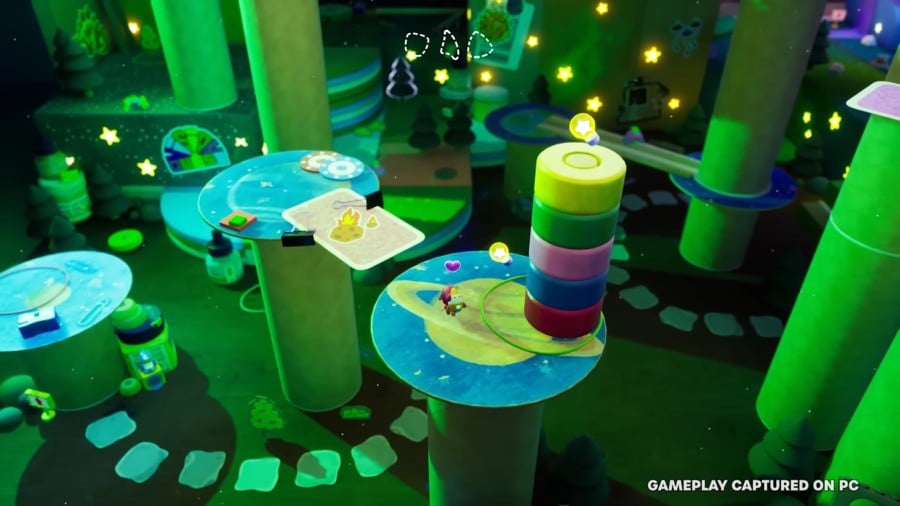
All this time, we were walking around the desk, spotting stickers, drawings, paper clips, and the like, and re-experiencing the magic of childhood discoveries. Finding some of these items – and even one of the candles required for unlocking the rocket on the table – inspired a question about playing with perspective and hiding things behind the “mess” on the table. “We discovered that same kind of thing when we were making [the levels], and so we’ve created a couple of things that will reward the player for that. We’ve got some things dotted around that you can find.”
We noticed other things that might be considered normal, but were important for grounding the story, such as UK power outlets (for “the outlet lore,” Turner chuckled) and the levels being set during day or night. And while the time period is deliberately left “a bit vague,” the aim was to create a world that had “a nostalgic feeling” to it. Essentially, like a kid’s bedroom that any of us might have had. We don’t get excited about power outlets in real life, yet there we were, sparkly-eyed and spotting those specific things. When we were rewarded with a piece of junk – part of a rocket ship – for completing a minigame, it captured the essence of our feelings perfectly. Kids find treasure in everything, and can be fascinated by tiny little things; paper clips, doodles, ripped paper, and plain old pencils. It felt like we’d been shown a photograph of our bedroom floor or our old desk.
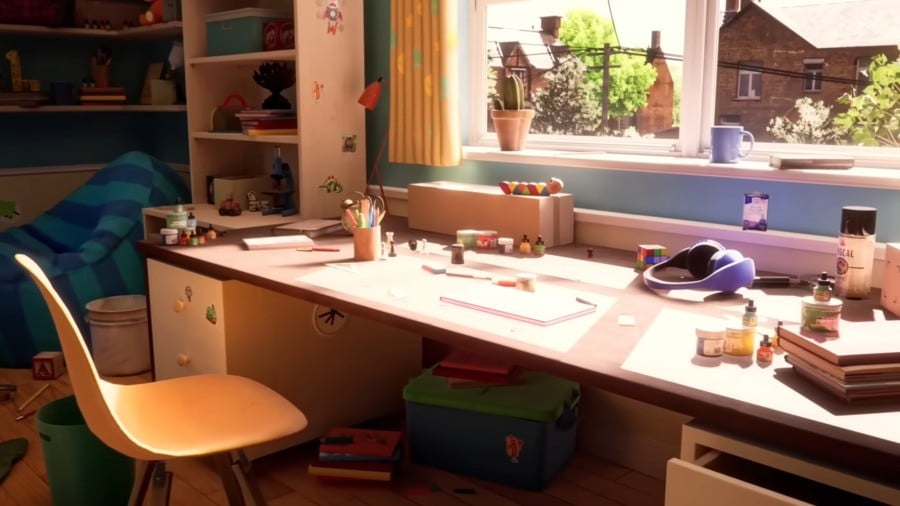
When we shared our feelings with Turner, he nodded. “If [playing The Plucky Squire] makes people feel nostalgic, or gets them thinking about their own childhood, that’s always a lovely thing to hear.” It’s a game about reliving your childhood, rereading your favourite book, and preserving that child-like creativity that we all missed. “We want [The Plucky Squire] to be a really nice experience for whoever’s playing. Forget the world a little bit. Enjoy yourself.”
And we did.
The Plucky Squire launches on Switch in 2024. Let us know how excited you are in the comments below.
With Jot existing before the game, albeit in a smaller capacity, we wanted to know whether James felt okay ‘re-using’ the character. “I think when you haven’t done anything that is really super established yet, aside from Pokémon or the official projects that you’ve worked on, no one really cares that much. A few people read my online comic, [if] I can transfer them across to the game… they might be happy to see him!”
Moving Jot – and other characters like Moonbeard (the in-game helper character) – from a cute online comic to a video game all about a children’s book felt completely natural. It was a “very early idea” to frame The Plucky Squire around a storybook that you can jump in and out of, all born from his art style.
“I have this simple, minimalist illustration style, and I wanted to make a game featuring that style. So I was thinking about what that could be, and the idea that came to mind was a kid’s book.” His early art was partially inspired by a storybook – Helen Nicoll and illustrated by Jan Pieńkowski’s Meg and Mog, a British staple – because of the “boldness of those illustrations”.
Discussions with his co-director Bidds evolved pretty quickly, with Turner soon thinking not just outside of the box, but outside of the book. To do that, the pair wanted to expand on an element that’s key to the game. “The idea of surprise was an interesting one to us. You turn the page and there’s a new surprise on every page [when you read a book]. And then we were thinking, ‘What could be the ultimate surprise? What if you could jump out of the book and run around?’”
It was a surprise every time it happened while we were playing. Even transitioning between the left and right page of the book, Jot goes from 2D to 3D as he somersaults through the air, and then back to 2D as he lands on the opposite page. That element of the unexpected is something the team found “kind of difficult.” There are gameplay shifts, secrets, and gameplay mechanics that have been hinted at or teased, but there are many more surprises awaiting.

“There’s always a push and a pull,” Turner expressed. “Marketing wants to show more of the game but at the same time they totally understand that you don’t want to give a lot away, but you want to put something cool and flashy in the trailer…. But you don’t want to spoil the experience.”
Right at the beginning of our time with the game, we were greeted with a charmingly-narrated section which felt like it was ripped straight out of a BBC kids show. When we asked about that, Turner – who is from the UK – nodded with a smile. “The narrator is Philip Bretherton. He was actually an actor in a BBC series, so he has that kind of experience. He’s great. I love working with him and recording all the narration. There’s a website for an agency called Damn Good Voices with loads of actors on there with little clips of their work, so we just went through them, trying to find the kind of voice that we liked.” The team knew when they found the right person because Bretherton was “not just the kind of voice, this is the voice.”

This is exactly the kind of attention-to-detail that stood out to us while playing The Plucky Squire. Translating Turner’s “minimalist” art style to 3D is something that works really well, and we couldn’t help but ask about the process behind making Jot look great in 3D.
“We were a bit too literal at first, actually. We did cell shading of Jot when he was outside of the book to make him look more like he does [in the book], but it kind of got rid of the feeling of weight of the outside world for some reason… [Because Jot is] the centre of your focus, [it] almost determines how the entire stage feels to you.” The team swapped to a “properly 3D-shaded” style, and Turner says that it immediately “grounded” the hero more. “We kept his face very simple… we didn’t give him the whites of his eyes, we kept those two marks.”

While the book and the element of surprise are two parts of The Plucky Squire, this is also a game about preserving creativity and allowing kids to express themselves. We saw so much of this throughout our time with the game, and Sam – the boy who is at the heart of the story and who loves The Plucky Squire book – has a presence that’s felt throughout thanks to the doodles on the desk, the stickers lying around, and who exactly makes all the mess on these desks. We didn’t see Sam himself, but we feel like we already know who he is.
The stickers, in particular, stood out to us – the level we played through was space-themed, so we saw aliens, planets, and quirky colours all adhered to the wooden desk. Those stickers were actually hand-drawn by Turner’s friends. One particularly noteworthy contributor was the designer of Geralt from The Witcher; we didn’t get a chance to ask who else may have contributed, but these are the kind of Easter Eggs that will have us digging around the game like excited kids.

If it’s not apparent already, children and childlike wonder are at the heart of the game. Turner explained the consequences of the game’s story to us. “If Humgrump [the villain who is trying to end creativity] takes over the book, that’ll be bad for their world but it will also be bad for Sam because it’s his favourite book and he’ll kind of lose inspiration. You’re fighting for your own world but you’re also fighting to keep Sam inspired.” And the set dressing really gives a sense of that childlike curiosity we want to preserve.
The Plucky Squire is “a topic of conversation” in the Turner household. “My son calls it ‘The Plucky Square’,” he told us. Turner’s kids have helped inspire some choices for the game, from showing them levels and testing right down to character designs: “I’ll show my son a design and get his approval for it – which one is cuter or which one looks cooler – and he’ll pick out the designs and then I’ll know which one is the best.” It’s surely a factor in how the experience feels as authentic as it does.
Of course, this leads to a lot of characters getting cut. “I think we’ve made two games, actually. Half of it is on the cutting room floor and half of it is in the game.” One such character that almost got the chop was the Jelly King, an NPC present in Chapter 6. At first, he was present in “a completely different form,” and instead of helping from the sidelines, “the Jelly King would follow you out onto the desk and you would bounce on top of him to get over high platforms.” However, the team thought that limiting the higher jumps felt too restrictive, so the jetpack ended up replacing the King. Luckily, they managed to get him back on the mug.

All this time, we were walking around the desk, spotting stickers, drawings, paper clips, and the like, and re-experiencing the magic of childhood discoveries. Finding some of these items – and even one of the candles required for unlocking the rocket on the table – inspired a question about playing with perspective and hiding things behind the “mess” on the table. “We discovered that same kind of thing when we were making [the levels], and so we’ve created a couple of things that will reward the player for that. We’ve got some things dotted around that you can find.”
We noticed other things that might be considered normal, but were important for grounding the story, such as UK power outlets (for “the outlet lore,” Turner chuckled) and the levels being set during day or night. And while the time period is deliberately left “a bit vague,” the aim was to create a world that had “a nostalgic feeling” to it. Essentially, like a kid’s bedroom that any of us might have had. We don’t get excited about power outlets in real life, yet there we were, sparkly-eyed and spotting those specific things. When we were rewarded with a piece of junk – part of a rocket ship – for completing a minigame, it captured the essence of our feelings perfectly. Kids find treasure in everything, and can be fascinated by tiny little things; paper clips, doodles, ripped paper, and plain old pencils. It felt like we’d been shown a photograph of our bedroom floor or our old desk.

When we shared our feelings with Turner, he nodded. “If [playing The Plucky Squire] makes people feel nostalgic, or gets them thinking about their own childhood, that’s always a lovely thing to hear.” It’s a game about reliving your childhood, rereading your favourite book, and preserving that child-like creativity that we all missed. “We want [The Plucky Squire] to be a really nice experience for whoever’s playing. Forget the world a little bit. Enjoy yourself.”
And we did.
The Plucky Squire launches on Switch in 2024. Let us know how excited you are in the comments below.






